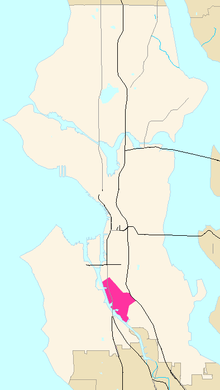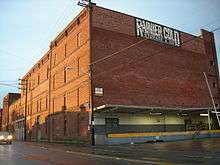Georgetown, Seattle

Georgetown is a neighborhood in Seattle, Washington, USA. It is bounded on the north by the mainlines of the BNSF Railway and Union Pacific Railroad, beyond which is the Industrial District; on the west by the Duwamish River, across which is South Park; on the east by Interstate 5, beyond which is Beacon Hill; and on the south by Boeing Field.
Despite being surrounded on all sides by industry and major transportation corridors, Georgetown retains a sizeable number of residences and businesses.
History

Georgetown is arguably the oldest neighborhood of Seattle. Georgetown's first settlement was founded on September 27, 1851, when Luther Collins, Henry Van Asselt, and the Maple family arrived with their household goods with the intention of farming the rich alluvial lands of the Duwamish delta.[1] Although the Denny Party arrived at Alki Point two days prior to the Collins Party arrival, the Collins Party was able to complete permanent structures and build a successful farming community within a year. The Denny Party suffered in relative squalor in an unfinished cabin and encampment until their move in 1852 to the future downtown Seattle area. The Collins farm was located in the vicinity of the present-day First Avenue Bridge, running north to the vicinity of South Idaho Street, on the east bank of the Duwamish River.
Farms in the Duwamish Valley supplied the lumber-based settlement in Seattle. Wooden boat building also occurred on the Duwamish estuary as land was cleared for farming. Before land transport links with Seattle were established, the economic hub of the Duwamish was a boat landing at the approximate location of the South Lucille Street/East Marginal Way junction. In 1869 a Seattle saloon keeper rented a portion of the Collins homestead from Luther's widow Diana (Borst) Collins to run a horse track; the track became a regional draw spurring the establishment of saloons and other not-completely-respectable manly fun. Developer Julius Horton, brother of Seattle banker Dexter Horton, purchased a portion of the Collins homestead in 1871 and began to plat the lots that would become the community of Georgetown.[2]
1874 marked the beginning of the Duwamish community's transition towards a rail-centered economy. A five mile rail link was constructed between Steele's Landing on the Duwamish and coal mines in Renton, soon extended to Newcastle (east of Lake Washington) and other coal sites in south King County. By 1880 the line was extended north over the tidewaters on pilings and a small depot built near the later Union Station site.[3] Transcontinental rail service came through Georgetown in 1889, and with an abundance of flat land that Seattle lacked, Georgetown became the site of the rail yard servicing the new freight traffic. The freight hub in Georgetown fostered the development of industries capitalizing on its access to resources and rail-to-market, including breweries, lumber mills, brickyards, and at least one foundry. With fill provided by waste from an early regrade attempt on Beacon Hill, the industrial area grew northward across the former tideflats.
With proximity to good hop-growing areas along the Duwamish and a large contingent of German immigrants, Georgetown became the sixth-largest beer producing district in the world.[2] Rainier Brewing Company has its origins in a Georgetown brewery that began operations in 1882 and incorporated as the Seattle Malting and Brewing Company ten years later. The company went on to build a five acre brewery north of Georgetown and market its product as Rainier Beer. The red brick brewery, home to artists and small businesses, dominates the commercial district along Airport Way S. Recent years have seen the opening of several microbreweries with pubs in Georgetown, in a nod to the neighborhood's roots fitting with its revival as an entertainment and cultural district.
The unincorporated community was named Georgetown by Julius Horton, after his son, in 1890. In 1898 its first local school was established. In 1906 the Georgetown Steam Plant brought electric power to Georgetown as well as providing power for Seattle streetcars and the Seattle-Tacoma interurban line.
Georgetown incorporated in 1904 largely as a defense against prohibitionism in Seattle, which with its southward growth encroaching on Georgetown and a State law prohibiting manufacture or sale of alcohol within one mile of a dry city threatened Georgetown's saloons and breweries. With Seattle increasingly cracking down on public sinfulness within its boundaries, Georgetown caught the windfall with its twenty-four 24 hour saloons, some of which advertised lodging arrangements, and horse racing track.[2] Georgetown existed as an independent city from 1904 to 1910, when it was annexed by Seattle; the Old Georgetown City Hall (1909) is now on the National Register of Historic Places as is the Georgetown Steam Plant (1906). The movement for annexation began in 1906 but did not gain significant support until 1909. Following presentation of a petition for an annexation vote, a special election was held on March 29, 1910. The annexation proposition passed with 389 votes in favor and 238 opposed. The City of Georgetown, with its 4000 residents, was officially consolidated with Seattle on April 4, 1910.
Georgetown continued to thrive as a growing industrial and transportation center of Seattle in the early years of the Twentieth Century. Improvements to the Duwamish waterway completed in 1916 made it accessible to ocean-going ships. The southern Elliott Bay harbor began its long-term process of replacing the central waterfront in economic importance. The main north-south automotive route through the Puget Sound region was established along Georgetown's western margin by 1926. The King County Airport opened south of Georgetown in 1928 and would facilitate the rise of Boeing as Seattle's major economic engine.
Following the burgeoning industry and trade came a decline of the residential neighborhood. The decline in population was steep in the postwar years for a number of reasons. Dated and downscale housing stock, congestion, and the worst air and noise pollution in the city made it an unattractive place to settle. A new warehouse and wholesale district grew in the core of the old residential area following the completion of Interstate 5 in 1962. Neighborhood stores closed, the library branch was closed in 1948, and the neighborhood movie theater closed in 1952. The neighborhood population was increasingly divided between elderly long-term residents and short-term renters. During the 1960s the Georgetown elementary school experienced an annual turnover rate among students of over 90% some years and enrollment declined to less than one third of what it had been during its peak. The school was closed in 1971. As of the 1990s, only scattered remnants of the old residential neighborhood remained, housing approximately 1500 residents with a poverty rate of 25%.[2]
21st Century Revival

Georgetown has had a certain degree of a "scene" since the 1990s. In 2001, Industrial Coffee and Stella Pizza were both hosting live musical performances. The former folded, and the latter stopped hosting shows and changed its name to Stellar Pizza. Since that time, however, quite a few new bars and coffeehouses have opened in the neighborhood, plus a record store, a beer store, a barber shop, a circus school (SANCA), a bakery, a scooter shop, a "skin sanctuary" (which is to say, a waxing salon), a web design company, and an art gallery/recording studio. Laura Cassidy of the Seattle Weekly described the prevailing aesthetic: "Creatively employing the open, airy brick-walled spaces left behind by industry and manufacturing, and augmenting them with local art and 20th-century detritus, Georgetown's merchants consistently fashion warm, imaginative interiors: places you want to visit and never want to leave. Just walking through the streets you witness post-squat, industrial bohemian chic."[4][5][6] Recent years have seen multiple-unit housing built in some of the remaining residential blocks near the old red brick commercial and industrial district.
Gallery
 Old City Hall
Old City Hall Offices, The Original Rainier Brewery
Offices, The Original Rainier Brewery The Georgetown sign
The Georgetown sign Sunset over industrial Georgetown
Sunset over industrial Georgetown The Hat 'n' Boots at Oxbow Park
The Hat 'n' Boots at Oxbow Park
References
- ↑ Greg Lange (October 3, 2000). "Collins, Van Asselt, and Maple (or Mapel) select first Donation Land Claims in King County on September 16, 1851". HistoryLink.org. Retrieved 2011-09-13.
- 1 2 3 4 http://www.historylink.org/File/2975
- ↑ http://www.historylink.org/File/1683
- ↑ Adriana Grant, Nightlife: Airport Way South. Georgetown: Where no one's around to complain about the noise, Seattle Weekly, October 25, 2006. Accessed online 9 November 2006.
- ↑ Laura Cassidy, Best of Seattle 2004: Best Neighborhood Makeover, Seattle Weekly, August 4, 2004. Accessed online 16 July 2014.
- ↑ Matthew Preusch, Surfacing | Georgetown, Seattle: From Brewers to Baristas in Seattle, New York Times, June 1, 2008. Accessed online May 25, 2011.
External links
| Wikivoyage has a travel guide for Seattle/Sodo-Georgetown. |
| Wikimedia Commons has media related to Georgetown, Seattle, Washington. |
- Georgetown Community Council
- Guide to the City of Georgetown Records 1903-1910
- Georgetown Neighborhood Park: A Vision Report for the Georgetown Community Council, Jones & Jones (architects and landscape architects), October 2001. Includes sections on Georgetown history, maps, photos, etc.
- Seattle City Clerk: Georgetown neighborhood
Coordinates: 47°32′35″N 122°19′14″W / 47.54306°N 122.32056°W